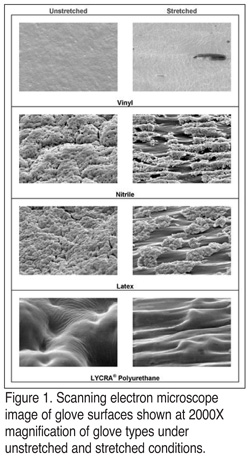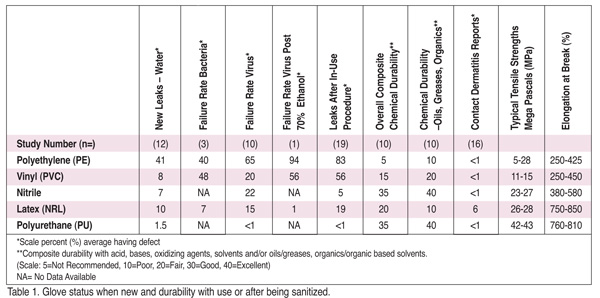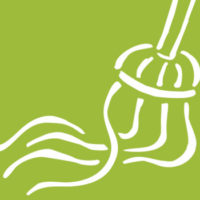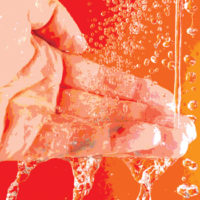Gloves in and of themselves are not a panacea, but rather it is their proper selection and use that can help reduce risks associated with commercial food handling. Gloves are meant to protect the product and the worker. If the gloves are torn or punctured, worn without being changed or sanitized, and the worker’s hands were not washed before donning, then risk is amplified rather than reduced.
The objective of this two-part article is to help food safety managers make educated decisions with regard to glove selection in critical food environments. Due to the variability of food types, handling configurations and risks associated with each facility and finished product, no specific recommendations can be made. Hazard Analysis and Critical Control Points (HACCP) principles must guide management committees in making responsible risk-based decisions that effectively deal with assorted microbial food hazards.
As discussed in Part I of this article, the current risk landscape is littered with glove tips and drips from punctured gloves.[1] It is no accident that glove parts end up in food. The stresses, strains, sharp corners, constant flexing and snags encountered in food processing require more physical strength and elasticity than commonly used glove materials provide. When inappropriate materials are used in food processing or service environments it becomes apparent that they are operating outside of their functional envelopes, and hence, breaks, punctures and leaks lead to contaminated food product. Studies in the health care field have shown that 50% of the time, glove wearers fail to notice glove punctures.[2] In many cases these are accidents just waiting to happen. When a puncture occurs, thousands of bacteria or virus particles can rapidly drip out of the breach.[3] When selecting gloves, important features to review are: break and abrasion resistance, durability, elasticity and resilience, tactile sensitivity and heat dissipation. The following review will delve into the pros and cons of the various glove types used in the food environment. The data and descriptions provided deal with the most commonly available glove products on the market. As in any general review, there will be exceptions due to proprietary processes and not all glove types could be explored in the space allotted.
Glove Types Detailed
Polyethylene (PE) copolymer gloves are generally the least expensive of all glove types. They are available in high-, medium- and low-density forms, which influence various physical properties. Typically loose fitting with a “one-size-fits-all” claim, dexterity is lower than that of any other glove type. While some could argue that the loose fit allows venting of the hand, PE gloves tear quite easily and are not suitable for use around high heat.[4] The heat welded seams on PE gloves are a typical failure region. A Conference for Food Protection issue submitted in 2004 sought U.S. Food and Drug Administration (FDA) Food Code status for “short task” PE food-handling gloves. This submission characterized PE gloves for use during periods of a few seconds up to two or three minutes. PE gloves are available with built-in antimicrobial compounds; however, it is doubtful that this feature is of value for a glove whose useful life is extremely limited.
 Vinyl (polyvinyl chloride), otherwise known as PVC gloves, are considered by some as an acceptable alternative to latex, providing snug fit capabilities and some degree of dexterity. They are more resistant to ozone and oil than natural rubber latex (NRL) and can be worn around heat sources without risk of melting.[4-6] Testing of vinyl has revealed that in some cases they begin leaking as soon as they are donned with stretch or snag on nail edges.[5] Electron photomicrographs in Figure 1 show how such punctures are created when the glove is stretched. Although vinyl provides better resistance to oils than NRL, its short usable life limits its utility in food applications.[9] Due to poor durability, lack of tensile strength and susceptibility to alcohol breakdown, they have been described by some in the healthcare field as “infection control nightmares.”[7-8,10]
Vinyl (polyvinyl chloride), otherwise known as PVC gloves, are considered by some as an acceptable alternative to latex, providing snug fit capabilities and some degree of dexterity. They are more resistant to ozone and oil than natural rubber latex (NRL) and can be worn around heat sources without risk of melting.[4-6] Testing of vinyl has revealed that in some cases they begin leaking as soon as they are donned with stretch or snag on nail edges.[5] Electron photomicrographs in Figure 1 show how such punctures are created when the glove is stretched. Although vinyl provides better resistance to oils than NRL, its short usable life limits its utility in food applications.[9] Due to poor durability, lack of tensile strength and susceptibility to alcohol breakdown, they have been described by some in the healthcare field as “infection control nightmares.”[7-8,10]
Nitrile (carboxylated butadiene-acrylonitrile) gloves were also developed as a replacement for latex. Like vinyl, they are less elastic than NRL but are significantly more durable.[10-11] They feature good physical properties and provide the wearer with good dexterity. Nitrile gloves are resistant to many chemicals but like other glove types are sensitive to alcohol degradation. They have been found to be sensitive to ozone degradation and the elastomers can be somewhat brittle, possessing a higher modulus and greater stiffness than NRL.[11-12] While they are abrasion- and puncture-resistant, once breached, they tear easily resulting in breaks where their varied colors help to identify glove pieces that may end up in food (Figure 1).[1,10] Nitrile gloves can be purchased at a moderate cost.
Natural Rubber Latex (NRL) is the most commonly available and often among the least expensive of the comfortable, tight-fitting elastic glove types. They offer good dexterity, a snug fit, good tactile sensitivity and can withstand high heat. For these reasons, NRL gloves were considered the gold standard in gloves for many years.[12-13] The downside of the material is that many people are now either allergic to latex or to the chemical additives used in the glove making process.[14] Latex particles and other chemicals can slough off into food product when the chlorinated glove surface breaks, as shown in Figure 1. NRL gloves will deteriorate over time by exposure to oxygen, ozone or ultraviolet light and are degraded by oils and solvents such as alcohol.[10,12]
Polyurethane (PU) gloves are free of chemical additives other than the pure polymer itself, consisting of polymeric methylene diphenyldiisocyanate. These glove types are head and shoulders above the rest with regard to high tensile strength and durability (Figure 1). The newer formulations have elongation at break comparable to NRL, making them very comfortable to wear.[15-16] PU gloves formulated with LYCRA polyester are resistant to abrasion, oils and to alcohol deterioration and provide reusability through in situ cleaning and sanitizing.[17-18] PU gloves dramatically reduce the chances of Type I and Type IV allergic reactions, as well as irritation dermatitis by not containing latex proteins, accelerants, plasticizers or sulfur vulcanizing agents common to all other glove types in one form or another.[16]
Glove Comparison and Selection Tips
 Table 1 summarizes key pieces of information relevant to glove performance for the main glove types used in the food industry. This table is a collection of data from several dozen articles published in various scientific and medical journals concerning glove test results and characteristics. Perhaps the most striking information provided by this chart is the frequency at which gloves are breached during in-use procedures where 56% of vinyl and 19% of NRL leaked post-procedure.
Table 1 summarizes key pieces of information relevant to glove performance for the main glove types used in the food industry. This table is a collection of data from several dozen articles published in various scientific and medical journals concerning glove test results and characteristics. Perhaps the most striking information provided by this chart is the frequency at which gloves are breached during in-use procedures where 56% of vinyl and 19% of NRL leaked post-procedure.
 Table 2 summarizes and supplements information on glove types provided in this article. No one glove solves every food application but as strength and durability increases, so does reduction of risk profile.[19] Mindful of puncture potential, supply issues and waste with certain glove types, some food safety managers are switching to or evaluating reusable polyurethane gloves that can be cleaned and sanitized on the fly. Ultimately, safety managers should match glove to worker and determine effectiveness through in-use performance evaluations. Managers should know and understand the performance characteristics of the gloves being used relative to the specific hazards associated with food and process type.
Table 2 summarizes and supplements information on glove types provided in this article. No one glove solves every food application but as strength and durability increases, so does reduction of risk profile.[19] Mindful of puncture potential, supply issues and waste with certain glove types, some food safety managers are switching to or evaluating reusable polyurethane gloves that can be cleaned and sanitized on the fly. Ultimately, safety managers should match glove to worker and determine effectiveness through in-use performance evaluations. Managers should know and understand the performance characteristics of the gloves being used relative to the specific hazards associated with food and process type.
1. Consider Working Load and Tensile Strength. Safe working loads for common glove materials are often exceeded many times per hour in modern food plant environments. Work with your glove supplier to specify the physical integrity that you require of these products. For example, the physical integrity of the glove used in meat processing over the course of a few hours needs to be very high compared to the deli counter, where the glove might be disposed of immediately after one use.
• Tensile strength is a good determinant of puncture and tear resistance. If running a high abrasion manufacturing process, stronger more durable gloves are dictated.
• Glove selection will depend on how long workers will be required to wear gloves for efficient operation. For example, latex research shows that barrier breakdown is in direct relationship with time worn.[20] In other words, for most glove types, risk of food contamination is directly proportional to time in-use.
2. Check for Allergic Reaction Potential and Insure Skin Health. Hand health is extremely important, therefore low- or no-allergen gloves are recommended.
• Look for low protein latex gloves to reduce allergy potential.
• Nitrile gloves are an alternative to latex, but contain many of the same chemical additives in latex gloves, minus the protein.
• If upon changing glove types, similar skin problems remain in some individuals, it is a sign that the problem was not solved and this may involve antioxidants, accelerators or other sensitizing chemical additives.
• Food handlers should carefully specify the chemical integrity required to the glove manufacturer.
3. Size Gloves Properly and Consider Ease of Donning and Comfort of Fit. With gloves, size matters.
• Tight gloves can restrict dexterity, cause discomfort and hand fatigue.
• Loose gloves that don’t have the requisite stretchiness represent a safety hazard to users and also can result in unnecessary fatigue.
• Cumbersome, loose-fitting gloves increase the risk of microbial contamination and transfer.
• Prevent excessive sweating by choosing a glove that allows heat dissipation versus gloves that do not. Cool wearing gloves reduce skin problems and discomfort while increasing worker efficiency.
• Glove flexibility and stretch are important determinants of comfort during use.
4. Ensure Proper Hand Washing and Glove-Changing Protocols. As noted, even the process of changing gloves is fraught with hazards, because many glove materials cause excess moisture build-up, causing difficult to disinfect contamination from the nail region to spread all over the hand.[21-22]
• Wash hands before and after wearing, so that the new glove or contact surface touched by those hands does not become contaminated before and during donning.
• To properly change gloves, each glove should be grasped in turn at the top of each cuff in a manner peeling the glove inside out.
• Unless it is a multi-use glove, which can be cleaned and sanitized repeatedly, single-use gloves must be discarded after the task is completed.
5. The Choice of Powder Free is an Important One. Powder was originally used to make donning easier with wet or dry hands and as a release agent to remove gloves from molds. This powder can aerosol latex allergens to a point at which they could be inhaled. Use of powders has been replaced by a chlorination step. This chlorination aids in the donning process, but also presents potential risk of skin irritation potential and food contamination.
6. Single-Use and Multi-Use Gloves are Mutually Exclusive.
• Single-use gloves must be discarded when soiled and cannot be reused.
• Multi-use gloves should be washed or sanitized regularly and by reusing them, gain economic, environmental and efficacy advantages.
• Multi-use gloves can be cleaned and sanitized many times more effectively than the human hand, in a sense taking hand hygiene to a higher level of efficacy and risk reduction.
Studies have shown that when gloves are worn beyond their design and structural limits, it is not a matter of whether a puncture, rip or tear will occur, but rather at what point in the process and how much product contamination will result. This may cause only minor discomfort on the part of the consumer, consumer affairs personnel and quality control manager, but it also could lead to something worse. It is the food safety manager’s job to eliminate foreseeable risks, building resilience and redundancy into a facility’s food safety system. If inferior gloves are used, made of materials that are not up to the job required, used incorrectly or under a flawed standard operating procedure, the inevitable result is amplification of risk.[7-8,19]
It may only be a matter of time before the piper gets paid. While a glove break in and of itself might be considered an upper warning limit, the fact is that the process is out-of-control at the point of leakage. If there is one thing we have learned from analyzing accidents, it is that we can’t slack off when running critical systems.[23] System complexity places high demands on a manager’s capacity to gather information and design effective strategies.[24] When analyzing catastrophes and how they happen, James Chiles writes, “Usually we can get through our days making many errors but never have to pay the bill.”[25] Obviously, these are days in which everyone, including the company at risk, skate happily on. But on really bad days, sometimes through multiple-failure chains of circumstances, things can (no pun intended) get out of hand. We must be aware of potential flaws in our food safety machinery—the human hand and our hand surrogates, the gloves—because under certain circumstances, little errors can cause big problems. Gloves used in food environments should be chosen based on their physical properties. It is key that barrier performance, durability, comfort of fit, tactile sensitivity, dermal compatibility and cost-effectiveness fit the task at hand.[19]
Barry Michaels is an independent consultant to academic institutions, government, industry and non-profit organizations and a partner in the B. Michaels Group Inc., an international scientific consultancy organization. Michaels has more than 30 years’ experience in the field of infectious disease investigation, control and prevention. Previously, he worked for Georgia-Pacific in the field of personal hygiene microbiology, product safety, regulatory affairs and product development.
References
1. Canadian Food Inspection Agency. HACCP Generic Model: Dried Meats (Beef Jerky). www.inspection.gc.ca/English/fssa/polstrat/haccp/jercha/jerchaie.shtml. 1997.
2. Dodds, R.D., et al. Self protection in surgery: in the use of double gloves. Br J Surg 77(2):219-20. 1990.
3. FDA. Office of Science and Technology Annual Report Fiscal Year 2000. Calculation of Virus Transport Through Barriers as a Function of Pore Geometry, p. 23-4. 2000.
4. Tacoma-Pierce County Health Department. Hot off the grill? The glove and allergy connection. Food Bites 12(2):1,3. 2002.
5. Fisher, A. Standard and special tests for the barrier integrity of medical gloves, part I. Current Content News, Vol. 59. February 1997.
6. Lewis, R. Hawley’s Condensed Chemical Dictionary, 12th Edition.1993.
7. Michaels, B. and T. Ayers. Hazard Analysis of the Personal Hygiene Process. Proceedings of the 2nd National Sanitation Foundation International Conference on Food Safety. October 11-13, 2000. Savannah, GA.
8. Leaky gloves have become infection control nightmare. Medical Post 34(1). Jan. 13, 1998.
9. Guzewich, J.J. The anatomy of a ‘glove rule’. Env. News Digest Fall:4-13. 1995.
10. Michaels B. Are gloves the answer? Dairy, Food & Env. Sanit. 21(6):489-492. 2001.
11. Welker, J. and C. McDowell. Nitrile emerges as a solution, not just as an alternative. Infection Control Today. March 1999.
12. Graves, P.B. and C.L. Twomey.The changing face of hand protection. AORN, 76(2).2002.
13. MARGMA. Malaysian Rubber Manufacturers Association Newsletter, 3rd Quarter 1999 KDN: PP7855/12/99. 1999.
14. Palaski, G. Latex glove prohibited. Conference for Food Protection Issue III-24. Council III Issues and Attachments. 2004.
15. Korniewicz, D.M. Types of gloves. Infection Control Today 3(5):52-3. 1999.
16. Warneke, D. Personal comm. 2004.
17. Bettin, K., et al. Effectiveness of liquid soap vs. chlorhexidine gluconate for the removal of Clostridium difficile from bare hands and gloved hands. Infect Control Hosp Epidemiol, 15(11):697-702. 1994.
18. Pitten, F.A., et al. The efficacy of repeated disinfection of disposable gloves during usage. Zent. Hyg Umweltmed, 201(6):555-62. 1999.
19. Michaels, B., et al. Prevention of food worker transmission of foodborne pathogens: risk assessment and evaluation of effective hygiene intervention strategies. Food Service Technology, 4(2):31-49. 2004.
20. Albin, M.S., et al. Anatomy of a defective barrier: sequential glove leak detection in a surgical and dental environment. Crit Care Med 20(2):170-84. 1992.
21. McGinley, K.J., et al. Compositional density of microflora in the subungual space of the hand. J Clinical Micro, 26:950-3. 1988.
22. Lin, C.M., et al. Influence of fingernail length and type on removing E. coli from the nail regions using different hand washing interventions. J. Fd. Prot., 65:117. 2002.
23. Perrow, C. Normal Accidents: Living with High-risk Technologies. Princeton University Press. Princeton, NJ. 1999.
24. Dorner, D. The Logic of Failure: Recognizing and Avoiding Error in Complex Situations. Metropolitan Books, NY. 1996.
25. Chiles, J.R. Inviting Disaster Lessons From the Edge of Technology. Harper Collins. 2001.



